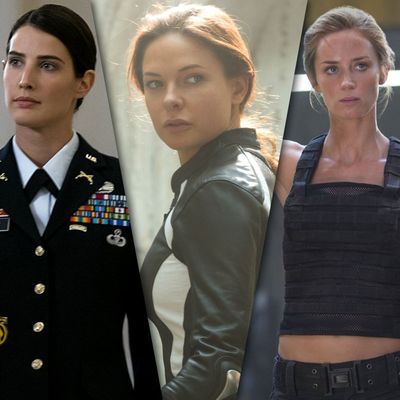
This weekend, Tom Cruise returns to theaters with the second installment in the Jack Reacher film franchise, Jack Reacher: Never Go Back. Much like last time, Cruise’s Reacher is called upon to clear the name of an innocent person saddled with a heinous crime, in this case, his former commanding officer Susan Turner (Cobie Smulders). It’s the latest installment in the Cruise Action Canon, a set that started in earnest with the first Mission Impossible back in 1996 and has carried through six installments in that franchise, two Reacher movies, and a handful of one-offs like Oblivion, Minority Report, and Edge of Tomorrow. And while these films are all marked by incredible stunt sequences and formidable fight choreography, they’re also notable for something else: providing the best safe spaces for women in all of action cinema.
Short of playing a Mockingjay, being Tom Cruise’s female co-star is the highest-profile showcase for women in the whiz-bang genre to kick ass, be sexy, and outwit their opposition, without having to worry about being grossly objectified or used as a prop to demonstrate the virility of a male lead. In his own strange way, you could make the case that Tom Cruise — onscreen, at least — is the feminist action hero 2016 needs.
Before Jason Bourne arrived on the scene, Cruise’s Ethan Hunt was pitched as the American answer to James Bond. But where the two spy franchises differ most is in the treatment of those women. The women in Bond’s life exist to be killed, rescued, or in their highest form, to save him from himself. Even Monica Bellucci, the rare actress who was Bond’s equal in age, experience, and star power, only had a few minutes of screen time in Spectre, and her big scene still culminated in a seduction. Spectre’s other female lead, Léa Seydoux’s Madeleine Swann, was equally shortchanged, serving as little more than a mannequin to be kissed. The overt womanizing of the Sean Connery and Roger Moore eras may have been trimmed down to the occasional cheeky one-liner, but the Bond films — and most action movies that don’t have Fast or Furious in their titles — have still struggled to transform their female characters from objects to subjects.
All of this makes the female co-stars in Cruise movies so noteworthy. No matter how big or small their roles, they are fully fledged characters; active, not reactive. Take Seydoux, who along with Olga Kurylenko has had the distinction of playing opposite both Bond and Cruise. The difference is remarkable; in her few scenes in Mission Impossible: Ghost Protocol, Seydoux had more compelling moments than in the entire movie she spent as a Bond Girl. As the stoic assassin Sabine Moreau, she was a killer with purpose, a villain who did not fear the best because she’d “killed the best.” Her fight scene with Paula Patton was a highlight — when she got kicked out that window of the Burj Khalifa, you were sad to see her go.
Even as love interests, actresses like Andrea Riseborough and Kurylenko in Oblivion and Michelle Monaghan in Mission Impossible III have dynamics with Cruise that are clearly rooted in mutual care and affection. Their sexuality is not a prize that Cruise alone possesses, and it’s never exploited by his antagonists, either — a refreshing change from films where rape is used as motivation for male leads. In Knight and Day, Cruise even literally apologizes to Cameron Diaz’s character for touching her without her explicit consent, and invites her to punch him in the face. All these women benefit from the innate sexlessness of Cruise’s star image: With the exception of his turn as an over-the-top musician in Rock of Ages, you have to go back to Vanilla Sky in 2001 to find a woman taking her clothes off for Cruise.
And over the past few years, Cruise’s action films have leveled up his female counterparts until their abilities have matched or exceeded his own. Emily Blunt’s Angel of Verdun was the primary ass-kicker in 2014’s Edge of Tomorrow, and Cruise spent most of that movie learning how not to be a dead weight around her neck. And while Cruise was as capable as ever in last year’s Rogue Nation, franchise newcomer Rebecca Ferguson stole the show as a disavowed secret agent — so much so that she’ll be making a rare return in MI: 6 next year. And in Never Go Back, it’s Smuldurs who pops off the screen when Cruise slips into a kind of auto-pilot hero mode, finally getting the chance to be the action star we’ve only seen tiny teases of in the Marvel films. As the movie takes pains to make clear, Reacher and Turner are peers.
In none of these movies do Cruise’s characters suffer from having a female equal. And the films themselves are often better as a result, as the strength of his female leads move them further away from the genre’s reliable formulas. You get the sense that, as he approaches 60 Cruise is more than happy to share the responsibility of anchoring a blockbuster action movie. It’s almost as if he’s creating a kind of hero apprentice program. When Cruise finally does retire from the Impossible Missions Force, maybe one of those successors he’s been grooming can take the lead, with a rotating cast of male support figures. You know, to give the underdogs a shot.


